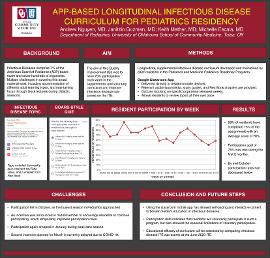| dc.description.abstract | BACKGROUND: Infectious disease comprises 7% of the American Board of Pediatrics general pediatrics board exam and covers hundreds of different organisms that cause disease. Covering each of these topics all together in one presentation at our weekly academic afternoon quickly becomes overwhelming. Additionally, we understand residents have dozens of other responsibilities. Our aim was to develop a longitudinal weekly curriculum that could be replicated at other programs that would deliver the required material to all residents, allow residents to cover material quickly at their own pace, and improve Infectious Disease sub-scores on the in training exam.
METHODS: Starting in summer 2019, the Pediatrics and Medicine-Pediatrics chiefs at University of Oklahoma-Tulsa School of Community Medicine have developed a longitudinal infectious disease curriculum that uses technology to aid in education. Every week, a short board-style quiz is released to the residents via Google Classroom, which gets pushed directly to the phones of our residents. Each week a different organism or group of organisms is covered, focusing on the most common organisms on the test. Google classroom allows us to attach study guides, the appropriate Red Book chapters, and YouTube videos that explain each topic, allowing for residents to review topics and answer questions at their own pace.
RESULTS: We have recommended, but have not required our 24 residents to complete each assignment. Since beginning the project, 58% of our residents have completed at least 75% of the assignments with an average score of 70%. Initial participation was robust, but as the busy winter season approached, participation rates decreased. Reminder notifications, and an incentive was introduced in the winter which temporarily improved participation from 54% to 75-83%. Our academic benchmark is to measure average infectious disease In-Training Exam sub-scores per class in comparison to our baseline test in June 2018 and 2019.
CONCLUSION: Educating residents on infectious disease as a year-long longitudinal curriculum has the potential to be an effective way to present material relevant to the ABP General Pediatrics exam. Providing this content as an mobile-app based curriculum allows for self-pacing and interactive content. Our first cycles have shown residents will voluntarily participate in this curriculum and the seasonal limitations of voluntary participation, with possible steps programs could take to improve participation. The extent to which this curriculum improves ITE sub-scores will be determined at the next exam this summer. We hope this information can be used by other programs wishing to implement similar curricula. | en_US |


